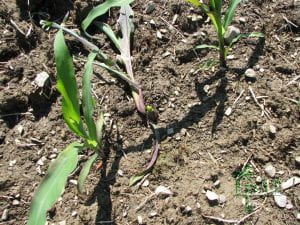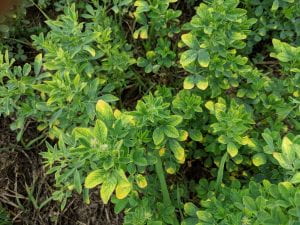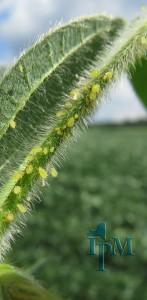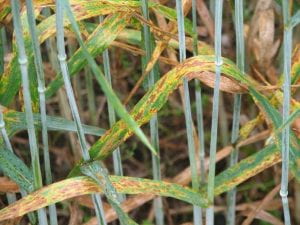NYS IPM Weekly Field Crops Pest Report-June 21, 2022
Black cutworm
There were more intense catches with black cutworm this last week. With the number of storms this year, we have had many black cutworm moths caught. There have been reports of black cutworm over threshold in many areas of the state.
When your corn reaches the V6 stage of growth black cutworm does not continue to feed. If the corn is younger than V6, it is best to get out and scout fields. The threshold is 5% or more of the plants have been cut is the point to employ management. For more information, please few the following website:
Black Cutworm
https://cals.cornell.edu/field-crops/corn/insects-corn/cutworms
Field Corn Pheromone Trapping Interactive Map
Black Cutworm Degree Day Accumulations by Location
| *Location for Intense Catches |
Black Cutworm (Base 50) |
Life Stage |
|
Seneca Falls Seneca County April 26 25 Moths Caught |
656 |
Pupate No More Feeding |
|
Avon Livingston County May 12 23 Moths Caught |
617 |
Cutting Corn Plants 6th Instar |
|
Rush Monroe County May 15 39 Moths Caught |
564 |
Cutting Corn Plants 6th Instar |
|
Hounsfield Jefferson County May 16 25 Moths Caught |
447 |
Cutting Corn Plants 6th Instar |
|
Casterland Lewis County May 16 23 Moths Caught |
447 |
Cutting Corn Plants 6th Instar |
|
Canton St Lawrence May 16 37 Moths Caught |
443 |
Cutting Corn Plants 6th Instar |
|
Seneca Falls Seneca County May 22 23 Moths Caught |
466 |
Cutting Corn Plants 6th Instar |
|
Munnsville Madison County May 29 27 Months Caught |
350 |
Cutting Corn Plants 4th Instar |
|
Housnfield Jefferson County May 22 25 Moths Caught |
397 |
Cutting Corn Plants 5th Instar |
|
Martinsburg Lewis County May 22 23 Moths Caught |
397 |
Cutting Corn Plants 5th Instar |
|
Farmington Ontario County May 29 23 Moths Caught |
374 |
Cutting Corn Plants 5th Instar |
|
Martinsburg Lewis County May 29 19 Moths Caught |
314 |
Cutting Corn Plants 4th Instar |
|
Oxford Chenango County May 29 15 Moths Caught |
380 |
Cutting Corn Plants 5th Instar |
|
Munsville Madison County May 31 20 Moths Caught |
316 |
Cutting Corn Plants 4th Instar |
|
Sterling Cayuga County June 5 16 Moths |
257 |
Leaf Feeding 1st to 3rd Instar |
|
Skaneateles Onondaga County June 5 22 Moths Caught |
238 |
Leaf Feeding 1st to 3rd Instar |
|
Cato Cayuga County June 5 26 Moths |
238 |
Leaf Feeding 1st to 3rd Instar |
|
West Sparta Livingston County June 12 17 moths |
198 |
Leaf Feeding 1st to 3rd Instar |
|
Rush Monroe County June 12 35 moths |
181 |
Leaf Feeding 1st to 3rd Instar |
|
Springport Cayuga County June 19 18 moths |
41 | Laying Eggs |
|
Seneca Falls Seneca County June 19 45 Moths |
41 | Laying Eggs |
*Intense Catch is over 15 moths in a week.
Black Cutworm Degree Days (Base 500 F) Lifecycle Growth Stages
Degree Days Stage Feeding Activity
0 Moth Capture Egg Laying
90 Eggs Hatch
91-311 1st to 3rd Instar Leaf Feeding
312-364 4th Instar Cutting Begins
365-430 5th Instar Cutting Begins
431-640 6th Instar Cutting Slows
641-989 Pupa No feeding
Potato Leafhopper
There have been reports of potato leafhopper in alfalfa in NYS. They do not overwinter in NYS and ride on storms from the south. Once here they lay eggs on alfalfa and many other host plants. When the nymphs hatch is when the damage occurs. You want to avoid damage by scouting now. If you see the V-shaped yellowing of the leaf tips it is too late. The damage on yield and quality has happened.
For more information on potato leafhopper in alfalfa view the following site:
https://cals.cornell.edu/field-crops/forages/insects-forage-crops/potato-leafhopper
Alfalfa Weevil
While there may still be a few fields with alfalfa weevil larvae most of them have pupated and will not be feeding on alfalfa until the next season. For more on alfalfa weevil please view the link to management information:
https://cals.cornell.edu/field-crops/forages/insects-forage-crops/alfalfa-weevil
Soybean Aphids
Soybean aphids have been reported in western NYS. These were not at threshold. It is thought that the 1st generation of soybean aphids migrating off buckthorn to soybeans are controlled by the insecticide seed treatment on soybeans. For more information on soybean aphid, view the following website:
https://cals.cornell.edu/field-crops/soybeans/insects-soybeans/soybean-aphid.
Stagonospora blotcin Triticale
Stagonospora blotch has been reported on triticale on the lower leaves. We see this common disease in most fields of small grains each year. See the following website for more information: https://cals.cornell.edu/field-crops/small-grains/diseases-small-grains





